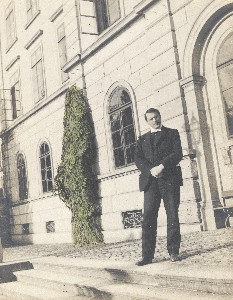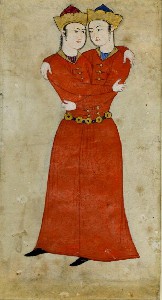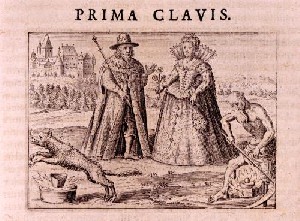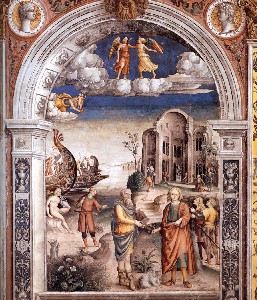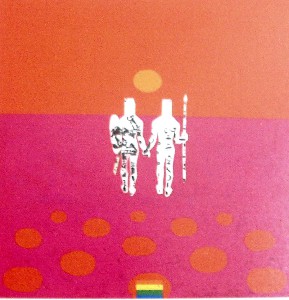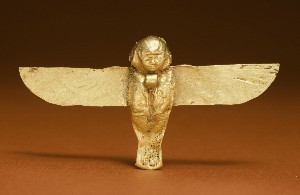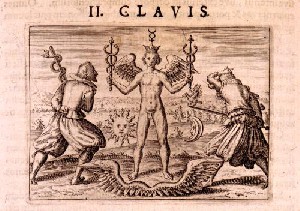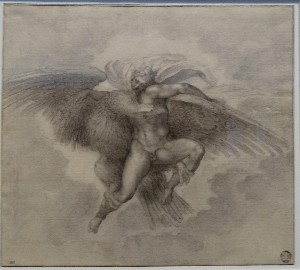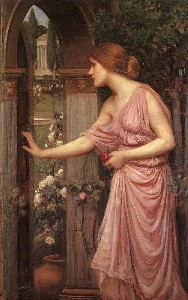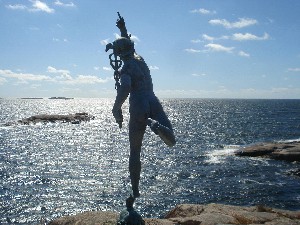By Mo Batchelor
Within the field of esotericism, Witchcraft and magick, heterosexual coupling has long been ascribed alchemical, magical and transformative potential. Many have found great beauty and meaning in this tradition of interpretation and exploration, and the more psychologically inclined have seen validation for this in Jungian psychology. I would like to follow up a few leads on a male same sex equivalent here. I am heavily indebted to Mitch Walker here, whose article at The Institute for Contemporary Uranian Psycholanysis website I have referenced throughout. Mitch Walker’s article [pdf] can be found there.
Jung, individuation and alchemy
Like many people of my generation, as a youngster I found Jung a delightful and open minded ally, especially as there was so much meaning for me in the occult and paranormal. Just his idea of “synchronicity” was an immensely useful tool in validating the way that meaning unfolds in our lives, independent of materialist causation. But both Jung and esoteric tradition seemed to often come up against a barrier of negative judgement or ignorance when it came to homosexuality and same sex relationships. For both it seemed that the model of sacred or normative sexuality and relationship was distinctly heterosexual.
Jung was more open minded, more sympathetic for sure, but he never went far in the direction of validating homosexuality or homosexual themes, and that was reflected in the Jungian influenced counterculture, whether it was areas of magic, or psychological astrology. There was a soft (or not so soft) dogma around the natures of men and women, and what the feminine and masculine must mean to each. It was as tiresome as it was inaccurate. People would serve up secondary causative explanations of gayness, seemingly taken from Jung’s own lack of understanding. No one seemed to stop and ask: “if we don’t even look for an etiology of heterosexuality, why do we assume that homosexuality must have an aberrant cause, rather than being a natural variation?”. It seemed many Jungian therapists had little insight into the processes that might be real for gay people, and this was paralleled by stronger religious intolerance, and esoteric aloofness. It was a world divided into spiritual castes, albeit a world in transition as society changed. Esotericism for its part had a long history of demonizing “the homosexual”, and had a habit of protecting its teachings from public criticism.
Carl Jung, standing in front of building in Burghölzi, Zurich [Public domain], via Wikimedia Commons
There have been a number of things over the years which have significantly shifted the conversation, and the information available for people. For instance Katon Shual’s Sexual Magick which came out in the late 80s (revised two years ago) brought up the subject of homosexual sexual magic positively. Books like Randy Conner’s Blossom of Bone have helped to redress the lack of coverage of homoerotic and transgender sacred themes in antiquity. There have also been books by authors such as Robert Hopcke covering theories and attitudes of Jungians towards homosexuality.
When I found the aforementioned article by Mitch Walker (written over 20 years ago) I was immediately struck by how powerfully it trod a line between the psychological and the esoteric, and that is why I am focusing on this article here, as I feel it has a great deal to offer.
Walker acknowledges and lists some of the distorted theories about male homosexuality that Jung himself expressed (e.g. that it is due to psychological immaturity, a “mother complex”, “anima identification” etc). He then notes:
“Nowhere in his writings does Jung articulate a soul psychology for homosexuals … But starting from his viewpoint on individuality, such a soul psychology of gays can be responsibly developed. … Models of gay individuation can then be articulated and explored, as has been done so profoundly in the work on individuation as heterosexual (that is, the coniunctio and the anima/animus as soul-image)”¹
Mitch Walker 1991
We already had profound models of straight individuation, and these models have become part of the language of psycho-spiritual growth for quite a few people both inside and outside esoteric studies, as if they were the universal human form. But these were not models of homosexual individuation. There were no formulated models of homosexual individuation, yet they must surely be there to be found. Mitch Walker goes on to say:
“becoming gay and living as gay must then involve the individuation of a homosexual relationship between the ego and the Self parallel to the heterosexually organized relations Jung has articulated, especially that concerning the Anima as soul-figure. Indeed, in a gay person the structures of personality organized by the developing libido will constitutionally individuate homosexually”
Ibid
Here we are not just talking about sexuality, but about personality, and relationships with and within the psyche that fit the developing life, and achievement of maturity, for a homosexual man. There is a point at which one realizes this, without explicit reference to psychology as such, but through personal experience. Everyone needs a language that comprehends that they are a valid person, who grows and matures and makes mature relationships, and homosexuality is as central to that growth and language for a gay man, as heterosexuality is to a heterosexual. It is so simple and so obvious, and yet utterly invisible unless one sincerely takes the beginning and the end to be the individual meaning which is real for that person within their experience. Jung, who was so concerned with meaning, I do think appreciated this in essence, but he was maybe born too early to see how much he was excluding.
As Walker continues, he outlines the understanding that both gay and straight boys identify as male from early on, then:
“in the subsequent stage differentiate alternative yet parallel sexual selves. Thus, in gay boys’ development just as for straights, sexuality and the self are not to be separated and in conflict but intertwined and interdependent, mutually fostering a lifetime of personal growth and fulfillment as gay. Both straights and gays are capable of the adult maturity described by Erikson and Kohut”
Ibid
It seems extraordinary that this would even be in question, but that is how far a lot of theory was from the lived experience of gay persons. In many ways this is reflected in persisting mainstream attitudes towards gayness, which conflate it with a form of transgenderism² and being not-truly-men. The reality of a gay man though is as male as any other man. But note “sexuality and the self are not to be separated and in conflict but intertwined and interdependent, mutually fostering a lifetime of personal growth”. This is a universal human observation. We might then ask what it means when in any religious, cultural or social setting, someone says “you can come in, but you have to leave your sexuality outside”. Or more especially where, such as in certain magical environments, sexuality is seen as centrally relevant and sacralized, but only if it is heterosexual. If sexuality and self-need to be intertwined and interdependent for healthy growth, then excluding a person’s sexuality culturally is a denial of selfhood and maturity.
On the organization of the libido:
“For a homosexually organized man, the ‘orientation’ of the god Eros would have to be gay, the relationship to phallus would be homosexual, the relationship with the feminine and the Anima would be a gay rather than a straight one, the actions of the libido, for example in the constellation of complexes and symbols of transformation, in the transcendent function, and so on, would occur through homosexually differentiated forms. The inner universe would be gay.”
Ibid
And really that is how it is if you are gay. You are not “fitting in” to a heterosexual unconscious. You are not seeking a dispensation from a heterosexual Eros etc, like getting a sick note to be able to watch from the side lines of your own world. Everyone gets their own, authentic relationship and process. Getting it without support can be hazardous, but there aren’t any second class citizens of the psyche.
Walker asks on what kind of basis a Jungian model of individuation can be constructed, where the libido has a homosexual organization? His answer is:
“Such a basis can be developed through analytic research into homosexually organized archetypes, as they can be studied in symbols and motifs from literature and other arts, mythology, dreams, visions and so on”
Ibid
Twins and doubles – gay male myths and themes
Walker cites an example from Plato’s Symposium which talks of Aphrodite Urania (daughter of Uranos) as the goddess of homosexual love, and Aphrodite Dione (daughter of Zeus and Dione) as the goddess of heterosexual love. Each of these goddesses had their own sons, an Eros each, one of homosexual and one of heterosexual love.
“Plato, thus, proposes two ‘homosexual archetypes,’ one female and one male, counterparts of two heterosexual archetypes, who embody and express a homosexual organization of gendered love and libido as counterpart to a heterosexual organization”
Ibid
He then goes on to describe the famous story of the origin of the emotion of love, where the original doubled humans are split in two, to make the two armed and two legged humans we are familiar with. Those who came from an originally two sexed individual strive to reunite with their other half in heterosexual love, while those who came from a doubly same sexed individual seek to reunite with their other half in homosexual love. Love is the yearning to regain the original unity. The former follow Aphrodite Dione and her Eros, the latter Aphrodite Urania and her Eros.
“In Jungian terms, the original Platonic hermaphrodite broken into male and female describes heterosexual development and the Anima/Animus dynamic, as Jung and other writers have discussed. It is all too typical that, in contrast to this treatment, the ‘union of sames’ in Plato’s story has not been discussed by these authors, or, as in one case, was mentioned but in a distorted, trivialized version. But Plato in his Symposium provides the outline for an archetypally-based image of homosexual love: ‘Each of us when separated, having one side only, like a flat fish, is but the indenture of a man, and he is always looking for his other half’ (Plato, 1956, p. 355)”
Ibid
Entwined Geminis, Safavid Dynasty. Persia/Iran 1630-1640 C.E. [Public domain], via Wikimedia Commons
You can feel that we are really starting to get somewhere here. Walker continues by making reference to the alchemical image of the coniunctio as the Royal Pair, the King and the Queen. He notes that this same royal pair can be seen in the astrological sign of Gemini, and in The Lovers tarot card.
I. CLAVIS, the first key, engraved by Matthaeus Merian (1593–1650) – Chemical Heritage Foundation [Public domain] via Wikimedia Commons
The mythology of Gemini is generally related to the twins Castor and Pollux (Polydeuces in Greek), “born” of one egg to their mother Leda after congress with Zeus in the form of a swan; however whereas Pollux was the immortal son of Zeus, Castor was the son of the mortal king Tyndareus. The twins were inseparable and had many adventures together, but eventually Castor was killed, and Pollux grieved so much that Zeus reunited them in the Heavens as the constellation Gemini. Castor and Pollux are also two stars within the constellation itself. Hyginus and Ptolemy though associated these two stars with Apollo and Heracles, also half-brothers.
Sign of Gemini – Giovanni Maria Falconetto [Public domain], via Wikimedia Commons
There are intriguing resonances within the myth: the egg that hints at the alchemical, the twins mortal and immortal, dark and light. We can recall other “twins” or pairings of sames that are crucially different: Cain and Abel, Set and Horus, Gilgamesh and Enkidu, Jesus and John the Baptist, John Dee and Edward Kelly, Aleister Crowley and Victor Neuberg, Thelma and Louise, on they roll, receding into the twilight.
Gemini is “the twins”, sames as well as opposites, and The Lovers card is ruled by Gemini (which in turn is ruled by Mercury). In fact Aleister Crowley refers to an alternate title for the card as “The Brothers”³. Walker notes that there are thus two occult images for the same position (carrying the meaning behind the coniunctio or sacred marriage). And in Gemini of course, we meet the Dioscouri, born from Leda’s one egg, placed in the sky by Zeus as a testament to their love.
“Thus, that image of the ‘union of sames’ articulated by Plato as a basis for homosexual love can be seen amplified as the figure of Gemini. The celestial Twins, therefore, express a symbolism of mutual relationship in which libido is homosexually organized. Through analyzing this symbolism, then, a homosexual organization of the developing gay personality can be exploratorily studied”
Ibid
And this is not just in terms of the psychological development of the gay personality. Just as the sacred marriage has both psychological and esoteric resonances, so too does the “union of sames”.
Mitch Walker notes that the Anima is a soul image in classic Jungian psychology, but that when Aphrodite Urania rules romantic love, then the situation of the feminine is going to be different. This has always appeared to be so for me, and the constant harping on the feminine and what it must mean for every man has always been one of the real drags of Jungian (and some esoteric) theorizing. Walker turns away from the motif of the King and the Queen here, and towards Plato’s image of two sames, “the Star Twins“, as a better expression of archetypal gay soul relationship.
“This image describes a symbolic situation of a man having a special, erotic, twin ‘brother’ who is felt to be the alluringly personified ‘source of inspiration.’ I have previously termed this male soul-figure the Double … It is a different figure than those described by Jung as the Anima, the Shadow or the Self, but can and does enter into the constellation of these other archetypes in a way analogous to the role of Anima”
What he then says about the history of the idea of the soul as a “double” is very interesting. He cites the Sumerian myth of Gilgamesh and Enkidu, a myth which I think probably holds resonances for a lot of gay men:
“In that story, the Sumerian king Gilgamesh is redeemed from a wasteful, purposeless life by … a strong man named Enkidu, specifically created by the gods as a ‘second image’ of Gilgamesh: may the image be equal to the time of his heart’ (Gardner and Maier, p. 68). Their love and union is explicitly likened to that between husband and wife, indeed, it is portrayed as ‘the paradigm of primary social relationships: male bonding, husband and wife, ‘brother and brother in one’ (Gardner and Maier, p. 42). Ultimately, it is through passionate love for manly Enkidu, a same-sex figure too grand and bright to be a Shadow, yet too weak and mortal to be the Self, that every-inch-a-man Gilgamesh finds spiritual realization and maturity”
Ibid
Gilgamesh and Enkidu By Bepege (from Mark Zulawski/University of Nicolaus Copernicus Emigration Archives (Own work) (CC-BY-SA-3.0 or GFDL, via Wikimedia Commons)
When Mitch Walker turns to Ancient Egypt we find ourselves delving into the subtle anatomy as envisaged by that culture. Within each person was an invisible being, a “source of life and breath” called the Ka. The Ka was shown as an idealized image of the person themselves.
“Your Ka was born into life with you, always embracing and protecting you with his love, and connecting you with the world of Paradise, with the deity. The Ka served in this capacity because, as the image of the beloved soul, it was itself a body containing within it a soul, just as the person contained the Ka within his or her own body”
Ibid
This “soul within a soul” was called the Ba, and was usually depicted as a small bird with the idealized face of the person. The Ba flew down from heaven during pregnancy and brought the “Light of God”, the Akh into the body of the Ka within the fetus.
“The Ba inseminated the Ka with the seed of Light, from which flowed the Waters of Life, animating the soul. In this way, it was actually the great Akh which brings life to mortal flesh, only to be withdrawn back into heaven upon the person’s demise. However, the Egyptians held an even more sophisticated view of the soul and its workings. They held that the Ka itself was actually the summatory expression of fourteen constituent aspects, each itself considered a Ka. These fourteen Kas, in turn, were grouped in seven pairs as the incarnation of seven distinct Bas, each with its own aspect. The qualities of the seven Ka pairs can be seen to portray a developmental sequence ………… Through development of these fourteen aspects of the Ka, the soul could thereby be ‘perfected.’ Perfection of the Ka was conceived of as a spiritual ‘ladder’ of development, up which a person could move, and thereby obtain a form of spiritual self-realization, portrayed as eternal residence with the Ka soul in heavenly paradise”
Ibid
Egyptian Ba Bird – Walters Art Museum [Public domain, CC-BY-SA-3.0 (http://creativecommons.org/licenses/by-sa/3.0) or GFDL (http://www.gnu.org/copyleft/fdl.html)%5D, via Wikimedia Commons
Interestingly, this “spiritual ladder” was thought of as belonging to Horus and Set, who helped the ascent up it.
“Horus and Seth are among the most ancient of Egyptian gods, and were seen to personify the workings of the eternal opposites, as they represented light and dark, just and unjust, in and out, and all such dyads. Their eternal struggle yet ultimate reconciliation has been aptly characterized by Joseph Campbell: ‘Mythologically representing the inevitable dialectic of temporality, Horus and Seth are forever in conflict; whereas in the sphere of eternity, beyond the veil of time and space, where there is no duality, they are at one’ (Campbell, 1962, p. 81)”
Ibid
According to Campbell the union of Horus and Set was known as “the Secret of the Two Partners”, and their united form was called “the double god”, shown as a single body with the heads of both Set and Horus. Walker also notes that there are texts where the pair are specifically likened to a man and his Ka, and to a man and his sexual partner.
“The relationship between a man and his Ba soul is also repeatedly likened to that between husband and wife in The Dialogue of the World-Weary Man with his Ba (Jacobsohn, 1968, pp. 29-34). In the latter text (ca. 2000 B.C.), the Ba says to his man, ‘In that stillness shall I alight upon you; then united we shall form the Abode’ of spiritual rebirth (Reed, 1987, p. 83)”
Ibid
As Walker says, the Egyptians held a belief about the development of the soul which involved the struggle and integration of opposites, and this is actually a feature of the coniunctio, which can be related to the unconscious and “soul making”, but based upon a marriage of man and man, man and male double; “a sacred union animated by a male-male eros, which leads to the integration of opposites and to psychic wholeness” (Walker 1991).
“Your soul, BA, become[s] conscious little by little in your incarnate KA. Our texts tell you that “he rises from your vertebrae”; from the dual fire in them, that is. That “he quickens your spiritual heart, opens your mouth and eyes to the Real”; that “being realised in you and having at last stripped you of your transient names, freed you from the humanity that is in your members,” he will “reveal your true face,” your face of Maat, and “make you one of the KAs of universal Horus.” (Schwaller de Lubicz, 1967, pp. 198-99) The idea of gaining this “perfection,” that is, individuation, through a gay sort of love echoes down from these original Egyptian and Sumerian ideas through subsequently recorded mythologies. Plato, of course, discourses at length on how this love leads to union with God, and similar ideas can be seen in Gnostic and Sufi thought. When the eye of homosexual libido is regard-fully opened, its worthy manifestations can be meaningfully perceived, and thus more accurately studied and better understood. Far from nonexistence, the phenomena of homosexual Eros have always been expressed by humanity, and can be reasonably observed when they are approached with respect and openness. From studying such phenomena an accurate conception of a gay male soul-figure and his workings in psyche can be (re)constructed”
Ibid
This is a quite extraordinary passage, both poetically, and with its resonances with Hindu ideas of the raising of the Kundalini, leading to a form of enlightenment.
Walker sees the Ka as an inspiring double through which a person can come to the Divine (in accordance with Egyptian teachings), and similar themes of coming to the Divine through a beloved “twin” or partner he sees reflected in Gilgamesh’s love for Enkidu which leads to “his initiation as a shaman”, in Socrates’ knowing “the truth” through his relationship with a beautiful youth, in Ibn Arabi finding Allah through his “Angel-Soul”. These are relationships of growth and realization that occur “through a cyclic rising and sinking of homosexual libido”.
Mercurius and the son of two fathers
“Jung has formulated the concept of Eros as the secret operator of the transformations by which the processes of individuation occur, a figure who both inspires and guides this process, and he has also seen this operator in the Egyptian Thoth, the Greek Hermes, and the alchemical Mercurius”
Ibid
II. CLAVIS, the second key, engraved by Matthaeus Merian (1593–1650) Chemical Heritage Foundation [Public domain]
And here it is interesting to note that Thoth is himself in some myths considered to be the child of a homosexual congress between Set and Horus, the “son of two fathers” as Walker says. Walker refers to this figure as “Eros as teacher”, and says that in terms of the soul the Egyptians referred to this kind of teaching figure as the “divine ka”, who guides his man towards spiritual self-realization, and a union of the human and the divine.
Of Thoth (Tahuti) Walker says:
“He represented the “fruit” of the sacred union of the Great Opposites: spiritual realization and knowledge. As such, Tahuti was considered the original shaman, the first alchemist, the first Gnostic, the archetypal initiate of the Wisdom of God, who is both the originator and product of the developmental process of self-realization gained through union with the Ka soul”
Ibid
The Ka here starts to look like the inward divine presence in the heart, the Lover or Beloved of various mystics.
On the European alchemical Mercurius Walker says he is:
“the cause and result of the operations which complete the opus. In fact, to effect the operations Mercurius, who is “duplex” (CW 13, par. 267), splits himself up into an active half and a passive half, and it is those two halves that are then called the King and the Queen, and it is they that combine to recreate Mercurius on a more refined level, that is, the process of “perfection” we examined previously, here gained through Mercurius’s submission, by his feminine half, to the inseminating union of his masculine half”
Ibid
So the King and the Queen are the two sides or phases of Mercurius, separated so they can recombine at a higher level. But Mercurius is the start and Mercurius is the end. Walker further claims that during the Middle Ages and Renaissance the figure of Hermaphroditos (“the basis for the alchemical combination”) may have been considered an allusion to homosexuality, as shown in woodcuts depicting the alchemist being inseminated “by the masculine spirit” in an act of anal intercourse. In similar vein, the story of Zeus and Ganymede was also employed by alchemists to represent “alchemical union and transformation”.
Ganymede abducted by Jupiter – Rubens photo by Jérémy Jännick (Own work) [Public domain or CC0], via Wikimedia Commons
“the twin-ship union could be perceived of as pro-creatively potent, as enacting a form of generation in its own right. Otto Rank was the first modern psychologist to identify ‘the self-creative tendency symbolized in the magic meaning of twin-ship. As the twins appear to have created themselves independently of natural procreation, so they were believed to be able to create things which formerly did not exist in nature;’ the twin-ship union has an ‘inherent creative power’ making the twins ‘independent of [hetero]sexual procreation’ (Rank, 1958, p. 92). Such generative capability gives the twin-ship union ………. the viability to sustain and further the individuation process in gays in a productive manner valuationally parallel to that occurring through heterosexual pro-creativity”
Ibid
In other words, the twins or doubles are an expression of a profound and primal psychic reality, and their union is erotically, magically and spiritually potent in a way which parallels the motif of heterosexual union envisaged as the marriage of the King and the Queen. Their pro-creativity is not physical, but then neither is that of the King and the Queen alchemically.
Sophia, Psyche and the feminine
The last thing that Mitch Walker deals with is the question of “the feminine” in gay men, which is important both for the weight placed upon the feminine by Jung, and on account of popular conceptions and misconceptions about gay men and femininity. To do this he goes back to Plato’s placing of homosexual love under the protection of Aphrodite Urania. Whereas in classical Jungian thought a man’s femininity is projected as the soul figure or Anima, for a gay man under the influence of Aphrodite Urania, the feminine falls into place as “a helpful attitude toward the masculine soul, that is, one of receptivity toward feeling love well”. Walker sees such a feminine homosexual orientation in Gnostic thought about Sophia and Jesus, and in the tale of Amor and Psyche.
Psyche Opening the Door into Cupid’s Garden by John William Waterhouse (1904) in Public Domain. Via Wikimedia Commons
“It is the Sophia, the Psyche in a gay man which allows him to orient to and gain union with the divine Eros (J. Clark, 1987, p. 11). From this perspective, the positions of Psyche and Ganymede are metaphorically the same. It is not a question of effeminizing an otherwise properly masculine person: In becoming and being gay, a gay man’s ego becomes attitudinally “wife” to his masculine soul “husband,” he attends raptly to psyche organized homosexually, so as to undergo the processes of union and transformation with the Angel within”
Ibid
Thus a gay man does not become less of a man, but in alliance with the feminine (not polarization and projection) realizes his own receptivity as a man and:
“becomes the crucible for psychic change and maturation via congress with and insemination by the Spirit of God, that is, the Self, in subsequent order to productively bear the Sacred Child of the Two Fathers. Through quickening relationship with this transformative union a gay man can meaningfully progress towards an individuated androgyny, and thus wholeness and completeness of being”
Ibid
Thus there is a homosexual alchemical opus.
***
The Garden
Jungian writing can appear very wordy, cerebral and over complicated, but I do believe it is useful, when mulled over poetically, digested and played with. Sharing in some of the areas of the esoteric, but being maybe more open to a humanistic and less dogmatic line of inquiry, it can also be a tool for extending our understanding of the esoteric, providing we don’t get too caught up in the head.
There is a way for gay men to mature and reach higher forms of human realization, and while it is not unconnected with the masculine and the feminine, it involves our own relationships to them, but those relationships still have to be genuinely soulful. Similarly the androgyne holds keys here, as it does with other forms of the alchemical opus, though I feel for gay men it holds particular virtues and particular hazards or pitfalls. The source Mercurius and the goal Mercurius are not the same, even if outside of time they ultimately are one.
Separation must still occur before recombination, for a higher form to be reached. I have for quite a few years been intrigued by two contrasting visions of the androgynous: the “mercurial” spirit that is reflected in the youthful, flighty, almost asexual sense of androgyny, and the realized, fully embodied, mature form of the androgyne, which I provisionally called the “gynander” to distinguish it from the former, though it most essentially is an inward realization residing fully in one’s own body at peace.
And lastly, I believe that gay men can come to a state of true peace with being male, being men, in erotic, libidinal and loving relationship with other men. This single-genderedness is part of our meaning and our functioning, and the mature form of our life.
Esotericism has not given same sex relationships anything like an equal place with heterosexual relationships in its scheme, but the esoteric content of same sex relationships returns, from myth and lore, and from the experience of those who have taken the road that is open to them.
It will continue to return. It may flower outside the walled garden, and in the wilderness, but it will continue to flower and to seed, and remind us that the garden was once a very different place.
Mercury on island of Källskär by ReinerausH (Own work) [CC-BY-SA-3.0, via Wikimedia Commons]
Footnotes
¹ Not that Jung was ill disposed towards his homosexual patients, he was progressive for his time, and he expressed forward thinking ideas e.g. “an individual’s homosexuality has its own meaning peculiar to the individual in question and that psychological growth consists of becoming conscious of that meaning”.
² The psychic processes of gay transmen are something which I do not have enough personal insight with to be able to offer any added or alternative suggestions for here, but every individual will have their own valid individuation process, and every grouping must surely have their own characteristic inner patterns.
³ Aleister Crowley – The Book of Thoth.
Mo is a Pagan warlock in his mid fifties. He is from England
and has had a long, idiosyncratic and varied spiritual history,
but has interests in Witchcraft, magick and Thelema going back 40
years, plus more recent influences from Sufism and Heathenry.
He is married to another warlock, with whom he shares his life.
He worked as a nurse for 23 years, before retiring to look after his
husband.

